|
Jul
24
2023
|
|
Posted 2 years 174 days ago ago by Admin
|
|
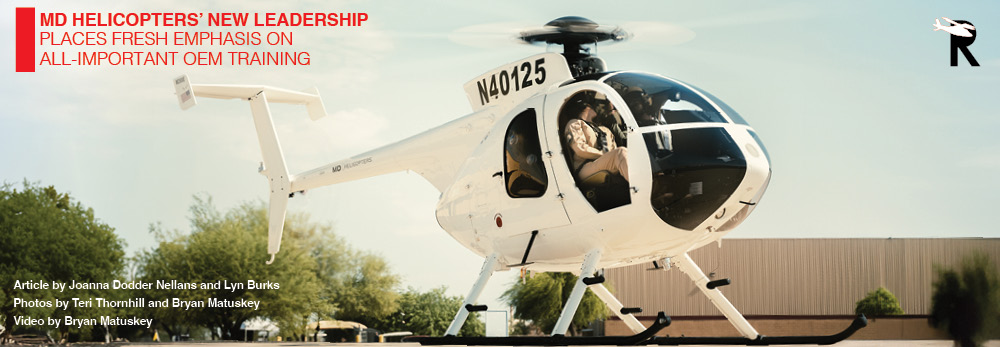
VIEW VIDEO
I want to be remembered for only one thing: my contribution to aviation. – Howard Hughes
There’s no doubt that Mr. Hughes is remembered in our industry for his contributions . . . or at least I hope so. I cannot help but wonder how many young aviators of this generation do not realize that the iconic MD 500 family of aircraft was originally developed by the Hughes Tool Company in the 1960s. Since then, there have been several owners of the OEM, thousands of aircraft manufactured, and even more pilots and mechanics trained, thereby keeping this workhorse in the game throughout several sectors of the helicopter industry.
With new leadership at MD Helicopters, this iconic brand is sporting an enhanced emphasis on training as a component of its aftermarket services.
"The primary goal since I came on was to improve our aftermarket, which encompasses spares, overhaul, repair and training," related Brad Pedersen, MD Helicopters LLC president and CEO since August 2022. "Training has sort of been a secondary function of the business; we want to make it a primary."
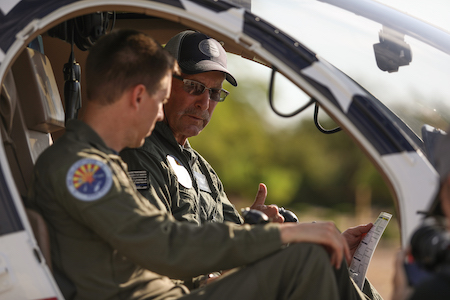
The new job is a return to roots for Pedersen. He brings more than 35 years of aerospace experience in leadership positions at Boeing Rotorcraft, Sikorsky Aircraft, Breeze-Eastern, and other aerospace and defense companies. And in 1983 he started his career at Hughes Helicopters, which later became MD Helicopters. He carries almost 20 years of engineering and leadership experience with the MD Helicopters product lines. And yes, he's enjoyed reuniting with MD employees who were there decades ago with him.
Pedersen has his work cut out for him. A consortium of creditors purchased MD Helicopters last year to lead it out of bankruptcy following multiple legal troubles under its previous CEO. The new investment consortium that owns MD Helicopters LLC (MDH) includes MBIA Insurance, Bardin Hill Investment Partners LP, and MB Global Partners. The previous name was MD Helicopters Inc. (MDHI).
"The new team of leadership has really brought in a breath of fresh air," observed Jason Lindauer, VP of sales and marketing who also started his career at MD as an A&P mechanic. "There's new insight, there's new motivation, there's a 'lean-forward' kind of attitude. We want to do the right thing for the right reasons for the customers, while taking a look at ourselves and really understanding where we can improve."
Spare parts had been a challenge for MDHI, said MDH Aftermarket Sales and Service VP Ryan Weeks, noting that MD Helicopters uses more than 700 spare parts. He wants enough inventory at the start of every month to be able to ship a part within 24 hours of the order.
While they are taking strong measures to improve their parts supplies, MDH leaders are highly confident in their pedigree and products such as the iconic light utility MD 500 series that's been in service for more than a half-century now. Originally the Hughes 500, the 500s were born from the military's Cayuse developed under the leadership of the legendary Howard Hughes, whose quotes still hang throughout the MDH headquarters in Mesa, Arizona. During its first year in service in 1966, the Killer Eggs set 23 world records for speed, distance and altitude.
"This thing is literally like a Ferrari," assured MDH Chief Pilot Dennis Banks, citing the MD 500's simplicity, low operating costs, agility, controllability and crashworthiness. It's highly regarded by the utility market which requires precision flying, he added, because "The instantaneous control gives you an incredible feel for the aircraft." It's also popular with the military, commercial, law enforcement and VIP sectors.
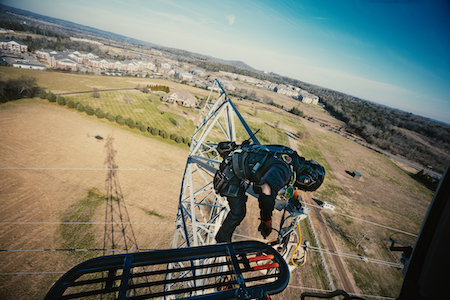
Do you value your training?
Imagine for a second that you are in a 300’ AGL out-of-ground-effect hover, with a 10-knot quartering crosswind, only 12 inches from a 500,000 volt high-tension power line, and a lineman is perched on a Tyler bench outside your helicopter.
Given the incredibly narrow margins for error, alongside the need for instant reaction in the event of an emergency, I’m certain that every pilot performing this work understands the value of quality training. This type of precision work happens every day in the MD Helicopters-dominated world of power line maintenance, repair, and construction operations, in which pilots rely on their training for safe operations. Other sectors such as law enforcement operations also rely heavily on MD Helicopters for the speed and smoothness of the platform so they can fly in challenging operational profiles that require high levels of training, especially in emergency procedures.
OEMs are the best for training pilots and mechanics, said Banks, who has extensive military and instructor experience. "Any questions that come up, we have the ability to get answers here through our engineering support staff," he elaborated.
MDH offers five pilot courses, five military courses, and a maintenance course. Instructors will travel to any part of the world to train customers on their own rotorcraft, and in the past four years that includes foreign military with the blessing of the U.S. military. For example, this year's contract for the sale of 12 Cayuse Warrior Plus scout/attack helicopters to the Nigerian Army includes pilot training in-house and in Nigeria, tailored mission training, and maintenance training.
MDH conducts its in-house training at its Falcon Field global headquarters and production facility in Mesa. The site's history dates back to 1941 as a military airport that trained U.S. and British pilots. It was deeded to the City of Mesa in 1948. Hughes Helicopters moved operations there in the early 1980s after winning a U.S. military contract for its Apache helicopters. Located in the Sonoran Desert with highly varied terrain, "We have very few weather days," Banks related.
Customers appreciate the opportunity to conduct certain types of training at Falcon Field on MDH-owned helicopters, Banks added – "because not everybody can afford to do full touchdown autorotations, for example, at home. It's high risk for their own aircraft, so they'll do those here. We assume that risk to make sure they're trained up to where they need to be."
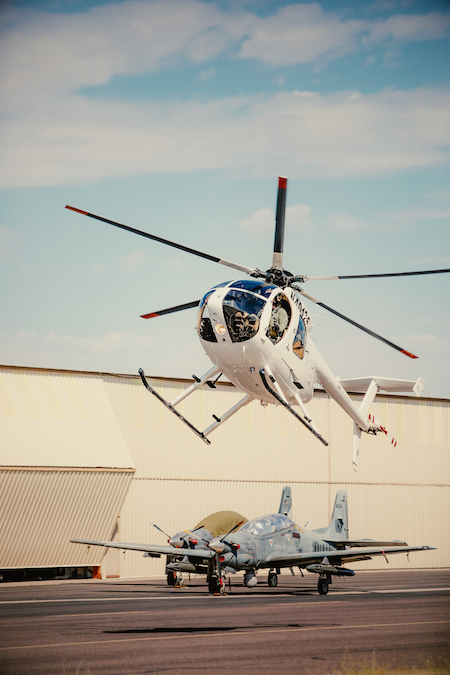
To emphasize that point of not utilizing operational aircraft for high-risk training operations such as touchdown autos, David McColl, a 12-year veteran utility pilot for several major utility operators flying MD products, says MD training has developed touchdown autorotation profiles that will challenge even the most experienced pilot.
"Most utility pilots think they are prepared to handle an engine failure – that is until an MD instructor rolls the throttle off on you at a 300' OGE hover with your head hanging out the door,” McColl said. “That's when you realize the value of factory training. It gets real, very fast. I have always said that pilots will rarely rise to an occasion, but they will default to their level of training.”
MDH trains an average of about 200 pilots and 100 mechanics annually, not including the training it provides for military pilots, mechanics and armament, Banks said. Each instructor normally works with a maximum of two students at a time.
"We go through every type of engine malfunction you can think of," Banks explained. "Most people don't die from the emergency; they die from the surprise and not being able to get over the surprise." Learning the various autorotation profiles allows pilots to increase their landing zone selections during emergencies.
Lindauer said the quality of MD training has never been an issue. "We do a spectacular job of training, and that is the consistent feedback from customers," he said.
While the MDH website details numerous types and levels of training, MDH can tailor its training to exactly what each customer wants, Banks said.
"The nice part about being a smaller OEM is that we also have the ability to change things as necessary," Banks said. "A lot of places just offer training packages – what you get is what you get. And we're not that way. We're about trying to get customers what they want and what they need to help the units be more successful."
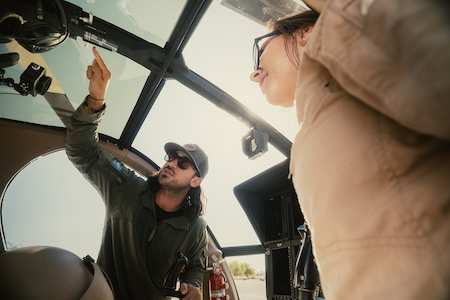
Case in point
In the fall of 2021, veteran utility pilot Anthony Brucie completed MD 500 factory pilot training where he and his instructor performed advanced touchdown autorotations (high OGE) to simulate the environment that utility pilots often find themselves in.
Several months later, Brucie was on a job working on power line structures. His next task was to depart the LZ with a 60' longline under the aircraft, fly the span of a couple structures, pick a lineman off the structure, and relocate him to another location. En route to the top of the structure, with the wind and power lines off to his left, the engine quit at 120' and 30 knots.
Brucie instantly entered autorotation, but could not turn immediately left and into the wind because the power lines were in the way. It was at this moment that his training kicked in. As he came into the flare, he noticed that his intended touch down point had a ditch running perpendicular to it. He needed to cross that ditch. At the bottom of the auto he traded off some RPM to extend the glide and was able to cross the ditch at about 10' AGL. As he leveled off and settled to the ground, and the last remnants of RPM bled off, the aircraft yawed and put the right skid on the ground first into a slight uphill slope. The yaw combined with the uphill slope was enough to cause the aircraft to roll. Fortunately, Anthony was able to crawl out of the helicopter and walk away.
Interestingly, within one week of the accident, his company suggested that Brucie return to MD to complete the training once more in an effort to get "right back on the horse again." As fate would have it, he had the same instructor again at MD. The idea was to keep the pilot from getting spooked, to reinforce the previous training that had likely saved his life, and to build confidence in order to get him back on the job. "In hindsight, returning to training following the accident was the best thing for me to resume flying, and there's no doubt that the training I received at MD played a large role in me walking away from a very tough situation," Brucie said.
Since it's a "one-stop shop," oftentimes armaments, maintenance and pilots all train at the same time, and that's valuable in creating a cohesive unit, Banks added. Numerous police departments conduct annual recurrent training with MDH at their respective headquarters. An MDH crew just wrapped up instruction with 12 Las Vegas Metro pilots, for example.
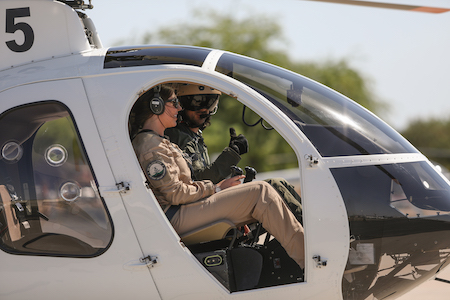
“Let’s kick the tires and light the fires” - Flying into the future
MD Helicopters LLC plans to produce 19 helicopters this year and increase production up to 50 by 2025, Pedersen said. MDH employs about 350 people, already up substantially from about 250 when he took over the helm. The company estimates about 1,700 of its helicopters are flying throughout the world today.
"The market is still really, really strong for this helicopter, and we think the future is really bright," Pedersen said. "We're increasing our focus on the customer, (and) training is an extremely important part of that...Training helps the customer perform their missions better, more efficiently and more effectively."
MDH is looking into ways to use VR and other animations to enhance its training, Banks added. It currently uses contractors for such training.
With another eye toward the future, MDH continues a 12-year tradition of offering 1-2 annual training scholarships to Embry-Riddle Aeronautical University students from Prescott, Arizona, and annual scholarships to the Whirly-Girls Scholarship Fund. The weeklong one-on-one training course in the MD 500 is conducted at Falcon Field. Students learn helicopter systems, emergency procedures and how to fly the aircraft.
"MD Helicopters is an incredible and long-time supporter of the Embry-Riddle Helicopter Program through scholarships, factory visits, training materials and industry feedback," said Dawn Groh, Embry-Riddle College of Aviation associate dean, in a scholarship announcement. "The connection and continual exchange of ideas with industry is a crucial element for our students' success, and enables us to be highly responsive in our training and curriculum to industry needs."
The quote “Let’s kick the tires and light the fires,” famously uttered by Harry Connick Jr. in the movie Independence Day, is the military aviation phrase that signals the aircraft is ready for takeoff. With Pedersen at the helm of MDH, and a renewed focus on pilot and mechanic training, there should be no doubt that current and future pilots will be ready to not only take off but also complete each mission safely and successfully. Lest we forget that old aviation adage, “Takeoffs are optional, landings are mandatory!”
VIEW FEATURE VIDEO
READ MORE ROTOR PRO: https://justhelicopters.com/Magazine
WATCH ROTOR PRO YOUTUBE CHANNEL: https://buff.ly/3Md0T3y
You can also find us on
Instagram - https://www.instagram.com/rotorpro1
Facebook - https://www.facebook.com/rotorpro1
Twitter - https://twitter.com/justhelicopters
LinkedIn - https://www.linkedin.com/company/rotorpro1